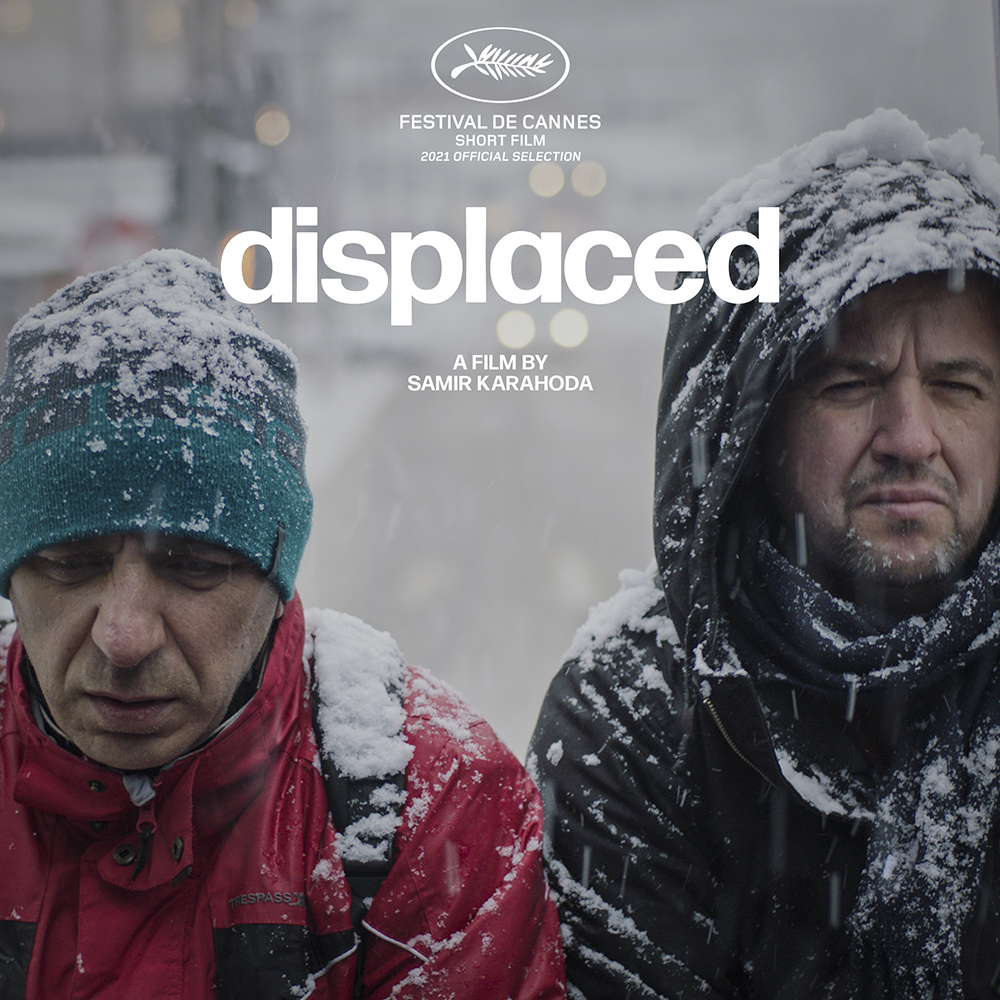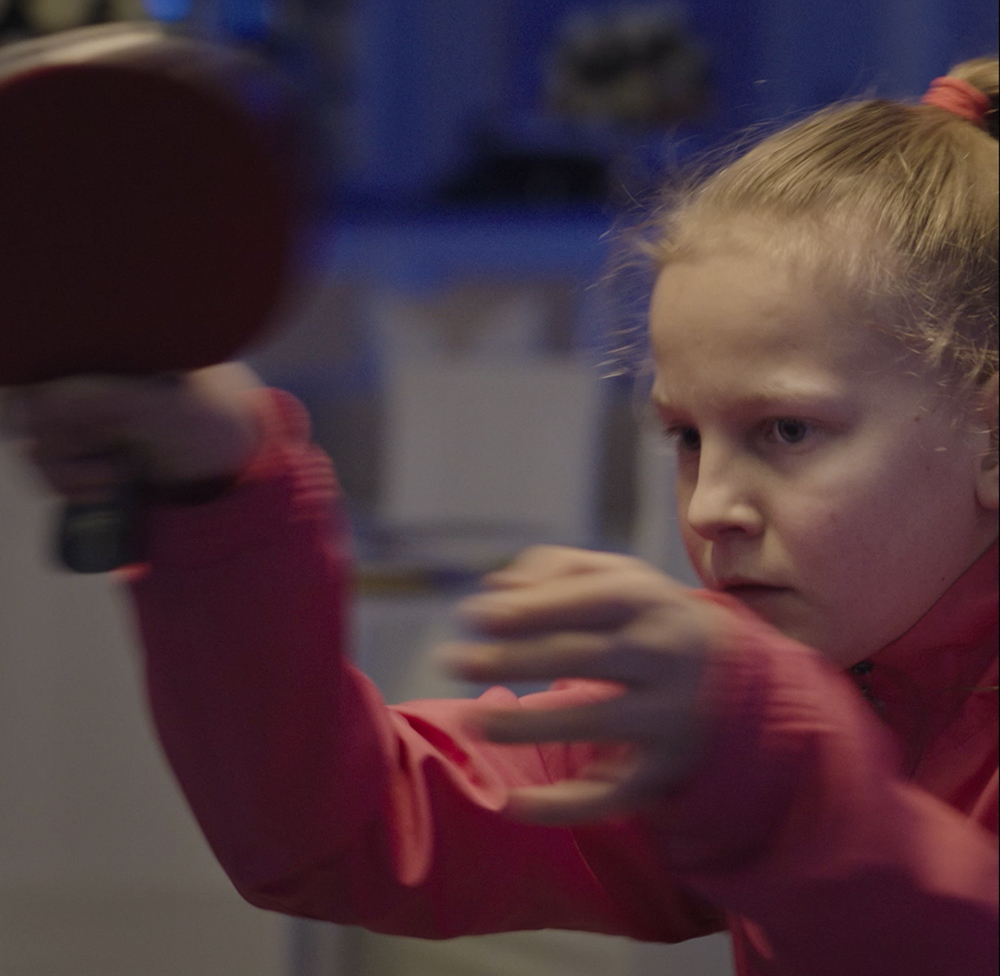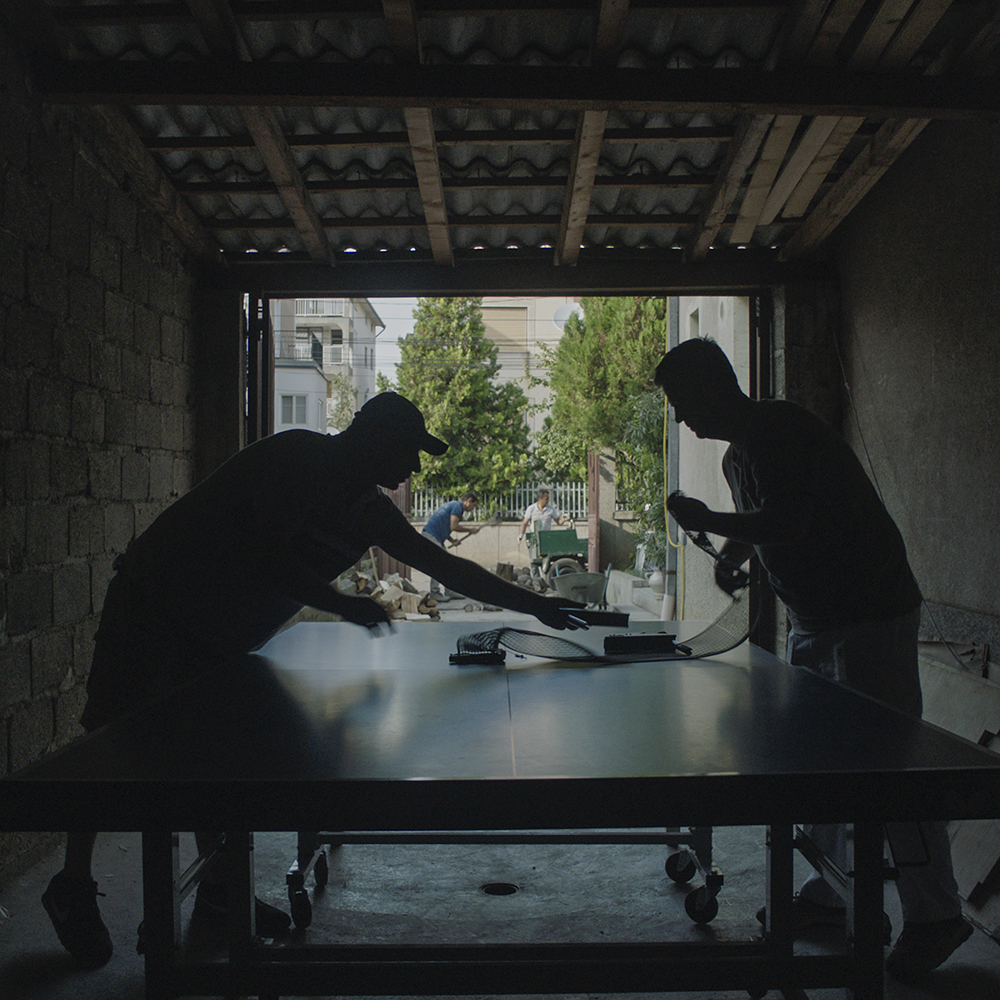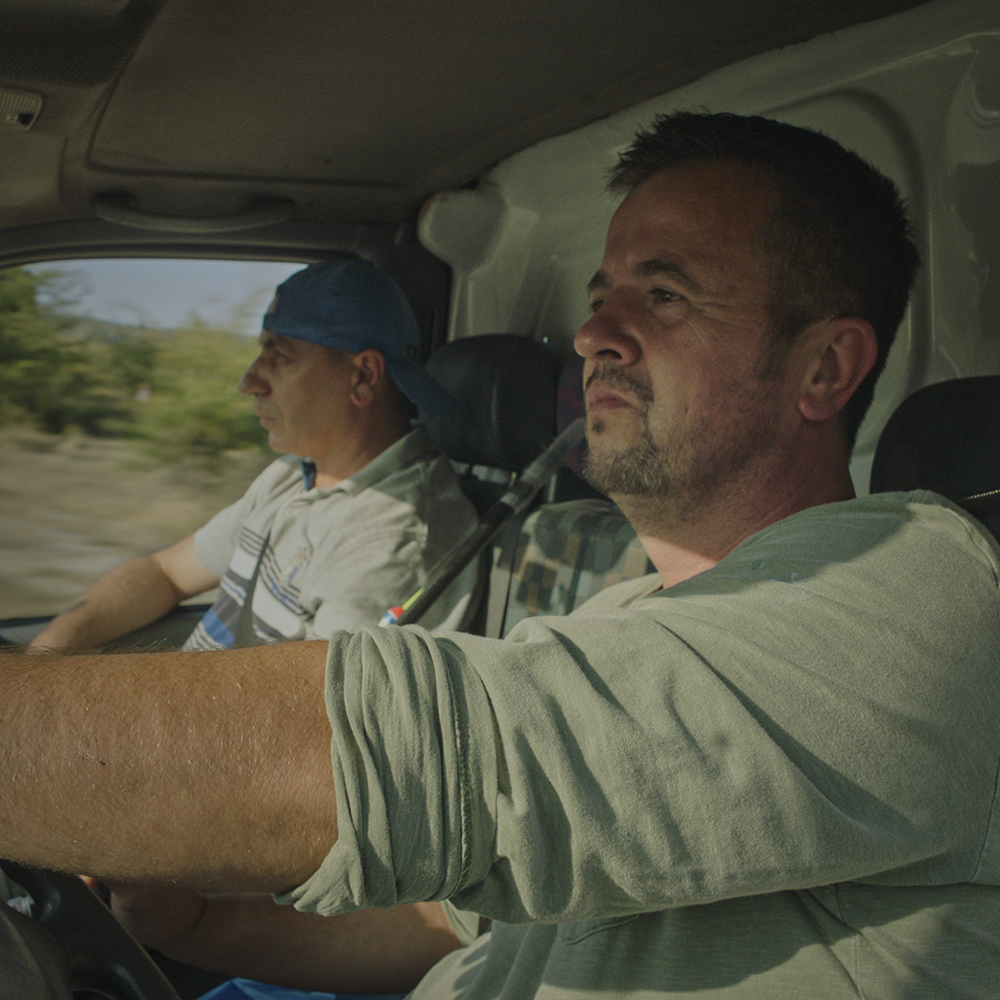Jeton Mazreku, Ermegan Kazazi and Rifat Rifati over the last 15 years have been forced to change the place of their ping-pong table hundreds of times. The two professional players, together with the coach of the table tennis club “Lidhja e Prizrenit,” have carried the sturdy rectangular table through the most unexpected and unimaginable places to play the sport.
For several years they stationed it in the basement of a church in Prizren. At other times, the table has taken its place in the middle of an unused wedding salon, generally during the winter when wedding celebrations await the warmth of summer. In comparison, the cellars and garages were the least weird and almost normal places for Prizren’s most important table tennis trio and the dozens of generations of children and youth of the town who were trained by Rifat.
Samir Karahoda, photographer, cinematographer and director, also from the city of Prizren, was closely observing and listening to the club’s problems almost from the beginning of the club, a few years after the end of the war. Even Mazreku himself, who is one of his closest friends, often confessed to Jeton the troubles and obstacles that resulted from the lack of a designated space.
“Tomorrow, before I go to work, I have to remove the table and take it somewhere else,”Karahoda recalls being told often by his friend during their evening outings. “I remember when in 2004 or 2005, they moved it to eight or nine different places during the year.”
It is no coincidence that Karahoda decided to document exactly this attempt in his second film “Displaced,” which shows how some individuals like Rifati, Mazreku and Kazazi have done their best to keep table tennis alive in their city. The film is in the form of docu-fiction, where the characters — Rifati, Mazreku, Kazazi and the children being trained at the club — play themselves, recreating current and past events of their lives. While the characters hit the ball back and forth, near the static camera a narrow frame barely contains the upper parts of the moving body, alluding to the lack of space and the needs of the athletes as a result of the system’s failure to support sports in the country.
.

The film “Displaced,” made in docu-fiction format, participated in the prestigious Cannes Film Festival.
The 15-minute film, which tells the history of 15 years of the club and of Kosovo, made new history for Kosovar cinematography this summer by participating in the Cannes Film Festival in the competition for the “Golden Palm” in the category of short films. For Karahoda, this is a continuation of the appreciation of his work by the highest film circles in Kosovo: his first film, the documentary “In Between,” was part of the international film competition “Berlinale Shorts” at the Berlin International Film Festival. Both films are supported by the Kosovo Cinematography Center (KCC).
Karahoda has worked as a photographer for most of his life, since the war as a filmmaker and cinematographer, and in recent years as a director. Together with the producer of his two films, Eroll Bilibani, both of them are an essential part of DokuFest — the International Documentary and Short Film Festival in Prizren. The film “Displaced” had its national premiere at DokuFest on August 7, at the Lumbardhi Cinema.
K2.0 met with Karahoda to talk about the table that has set the record for being moved the most in the history of table tennis, immigrants within Kosovo and characters who play themselves.
K2.0: A few days ago I happened to watch a documentary about Joan Didion, an American author and journalist. While talking about her hometown, Sacramento, California, she mentions the influence of geography and weather on how we build, and how often some nuances but also extremes of the city go unnoticed by most who have the usual routine, but take meaning in one’s creative work. I remembered this part while thinking about Prizren and your work. What are these nuances that you have observed, or that have even prompted the making of your films?
Samir Karahoda: In the documentary “In Between” these nuances play an important role, especially for the phenomenon I have dealt with, the issue of property in this case. Now I personally know many families, starting from my family, or to say more broadly every second or every third family in Prizren have problems with property. Most families do not talk with each other because of the uncertainties and because none of these problems have been solved by their parents. And I am very impressed by the way some family leaders have solved the property issue in the villages, in this case the parents, the father and the mother.
In Kosovo, this is perceived as something comic, but when I started analyzing this phenomenon I found these parents very reasonable. You also saw in the movie that [the characters] sometimes say, “While the parents are alive, it is good to comfort the children.”
However, what has prompted me the most to return to film as a director is the disregard we have received from the film community.
Really, they are so aware of where they live, where the law does not work properly, and are aware of what can happen if things are not fixed. And in Kosovo property is a sensitive and sacred issue for some families. These parents have been willing to sacrifice no matter how much it costs them financially, just not to break the harmony in the family and keep the children together. This has impressed me and I respect their decision despite the costs that they face because this is also the courage of parents who have worked all their lives.
K2.0: Cinematographers are usually said to be directors on hold. Has being part of DokuFest for a long time near thousands of movies influenced you to make this leap from photography and cameras to directing?
I can say that it has had an impact. Yet since I was a child, my dream has always been to shoot movies, and to go study cinematography in Europe. But this was very complicated due to the conditions and administrative issues in the ‘90s.
I started taking pictures in 1992 when I was 15 years old. And then I realized that there is a photography school in Turkey, and I went there, and I stayed for six years and studied photography. I thought I could get closer to cinema and film through pictures. I got back here and immediately started dealing with Dokufest.
But the whole time I was involved in film. I worked on the film “Kukumi” [by Isa Qosja, 2006] as a photographer. It was my first experience in the film. Then I slowly started working on small projects, documentaries and then shooting short films for other directors.

Rifat Rifati stands among the children of the ping-pong club “Lidhja e Prizrenit,” which he leads. He remains one of the most inspiring figures for Karahoda. Detached photo from the film footage of “Displaced”.
However, what has prompted me the most to return to film as a director is the disregard we have received from the film community. Foreigners had priority and we were neglected [for the reason] that we belong to Kosovo and we do not know. They have not given us many opportunities to develop as a filmmaker, or as a cinematographer.
No one is born a master. The more you work, the more you learn new things. I’ve worked in photography for over 20 years. I am a professional, but I still continue to learn new things, for example how to deal with difficult conditions. The whole experience makes you even more experienced.
This has been something that has bothered me a lot, and whenever the productions did not have a budget, they came back to us saying, “We are friends, or come and help us.”
At that point, I decided to make my own films, and shoot them myself. Today both films are appreciated for their cinematography.
The beginning of the ‘90s constitutes one of the most difficult periods of the country, when what we know today as the decade of oppression had already begun. I’m curious to know more about what were the circumstances that spurred this desire for photography and film, when there was no film production?
At that time, it was even forbidden to shoot films from the Milošević regime, because the last film [before the abolition of Kosovo’s autonomy in 1989] was made in 1987, and it was “Rojet e Mjegullës” [by Isa Qosja]. This was one reason why he had to leave Kosovo.

In Karahoda’s film, the table tennis players in many scenes are shot in close frames, alluding to the missing space and place for the club of this sport in Prizren. Detached photo from the film footage of “Displaced”.
It seems clear that in both of your films photography is the main tool of storytelling. While the script has more of an auxiliary role being used to fulfill any part that can not be understood only with pictures, which in fact is not conventional within the idea of the story …
I have also said this in an interview that the main part of the script and the film is photography. I usually see the scenes as pictures, and then of course in some places I have to intervene to break them down more and include a short dialogue, or a short dialogue with more meaning.
In both films we have a little dialogue, but it shows a lot about the problems that society has, especially in the film “Displaced.” There is dialogue in three or four scenes, but you understand what is happening in Kosovo in general. That’s the case in the garage scene where we realize that every young person today talks about how to get out, or how they got involuntarily returned.
Both films have a more dramatic, darker atmosphere, the same way as I see our country.
So the scene at the wedding salon when the owner of the place, with a little dialogue, reveals the character of the coach, Rifat Rifati, who is in front of him [when referring to the sentence: “I know what you have done for this place.”] In fact, the coach is one of the greatest patriots I have known in Kosovo, he is a coach who has worked for almost 40 years without compensation for Kosovo table tennis and is the president of the Table Tennis Federation.
Even today he works as an accountant in the morning, and in the afternoon he goes to train the children, just to keep the sport alive. And at the same time the three players of the club represent Kosovo [as part of the Kosovar team]. Rifat did not stop work even when everything was forbidden; in the ‘90s he was training children illegally in the garage, just so as not to interrupt their development.
Going back to the filmmakers, I see each scene as a photograph and I try harder to express my feelings through the atmosphere. Both films have a more dramatic, darker atmosphere, the same way as I see our country. I can not lie about anything, I only express how I see our country.
When I think about the colors of the movie, it comes to my mind that most of the time the scenes are shot in grim weather, right before a rainstorm, or even in the dark evening. We hardly see the open and blue sky. Does that mean the weather and such colors add gloom to the events you have in the movies?
Most of the time I was working on the ground, and every time I travel through the villages, especially during autumn and winter, you have that feeling of emptiness and then you feel sad because of this emptiness. You see houses with closed windows, with closed shutters. And all of this I showed in the first movie.
It has been a challenge to include 15 years in 15 minutes.
For example, we do not have music, which has been a challenge for the sound designer to keep pace and he has had to work hard. Because if I have to put a song in a certain place for him it is much easier than holding it for 15 minutes without music, with breath and noise. So the voice is also a very important part of the story.
Why did you decide that “Displaced” should be in the docu-fiction format?
The movie “Displaced” has almost 15 years of story inside and it has been a challenge to include 15 years in 15 minutes. For this reason this film has a different format than the first. I have thought long and hard about how to handle it and I thought that perhaps the best way is for some scenes to be fiction, as most of the film is a recreation of scenes that these people have experienced in real life.
Many say that it seems like a fictional movie because they are acting, but these actors are real characters, they are the table tennis players. It means we have no professional actors in the film, and that still makes the film a documentary, but at the same time makes them play their roles.
Why did you finally decide not to have any professional actors?
I thought about it a lot, and yet again I said that the story is theirs and they deserve to be there. I do not regret it at all because I do not think professional actors could have played the roles the same way the characters played themselves.
Perhaps I can say that I rarely had to give them suggestions to do this or that. But they have somehow entered into themselves as they were before.
They expressed their emotions so well, as in that scene on the tractor. They were already sitting and I had not made a sound. I had already told them that we will go around in Prizren and nothing else. The character who returned from Germany kept his head up because he said “I’m feeling this way and I’m happy because I did something good for this country.”
We had also done dialogues together in many parts. I prepared the scripts together with Zgjim [Terziqi], and in some cases they said, “No, it’s better this way.”
For example, that scene in the cafeteria, which is also a crucial scene where everything is understood, we did it all at the last moment together. I had shot it two days earlier and I was not happy with the result, even then we went that night and did the entire dialogue. Through that scene it is understood what happened and why it happened.

The young players of the table tennis club “Lidhja e Prizrenit”. Detached photo from the film footage of “Displaced”.
Symmetry finds great space in both of your films. In “In Between,” the symmetry within the composition of the frame also coincides with the theme of the film, the division of property equally and the maintenance of harmony within the family. In “In Between,” the symmetry also gives a sense of harmony, but that is even more in contrast to the gloom of the story. Can you elaborate on this use of symmetry?
Symmetry for me is a professional obsession and for “In Between” it fit because it has to do with architecture a bit. Even while researching the story I have seen some places … I spent more time researching places than shooting. So I decided to go with that shape or style and then I thought it’s also a good metaphor related to the context of the story that everything has to be equal.
Most of the story then relates to migration, because many immigrants living abroad have the question: To stay or to return? They all want to come back, but they can not come back because they do not want to live here.
I have often traveled through Europe and when we are talking with compatriots it is always a conversation about Kosovo, and it was clear that even those who lived there for 30 years followed the events here so much that they even knew some things better. They all think that they find it easy to live there and have good conditions, but at the same time they have a feeling of emptiness which no amount of money can fill.
So the title of the film came out of this — “In Between” — and it had more meaning that they were neither here nor there. And except for the title, it is also the starting point of symmetry.
He said: "Tomorrow before I go to work, I have to remove the desk and take it somewhere else."
Then with the second film, after I received good reviews for the photography I decided to keep this shooting style and maybe even make it as my signature, that tomorrow or the day after someone sees my films, they will know that Samir shot this movie, or that’s how Samir shot the movies.
Migration is one of the main themes in the first documentary, the characters are the relatives of those living in the diaspora. Though in “Displaced” it is not the main topic, migration still occupies a large place in references and allusions, especially in dialogue. It seems to be a phenomenon that preoccupies you. Where is the starting point for this?
The whole story is true and Jeton migrated to Germany before the war, when he received an invitation to go as a soldier from the Yugoslav Army (JNA) and was forced to flee. He returns after the war and we, if I am not mistaken, were notified in 2003.
And I am linking it to migration because it was a unique case. He also had a job, he had everything in Germany, but he came back to do something for his country. Unfortunately it did not turn out as he thought, but thankfully he is back, if we look at it for our country.
I return to the question of migration, and both films touch on the people living in Kosovo as immigrants. We see a lot of films about immigrants living in countries that have migrated and few films have been made about immigrants living here.
Eventually both films touch on the deeper system that needs to be better analyzed and understood. In both films we see that when a system doesn’t work well the society is the victim. In this case the victims are the athletes, and in the first film the victims are the family members.
And at the same time I consider migration as an inseparable part of our people. If it wasn’t for the immigrants and compatriots, I do not believe this state could stand on its own two feet.
If we had better conditions, we would not have three medals now, but six or more. It is very easy to draw pride from the TV, as long as no one does anything to fix things.

Table tennis players have practiced their profession in garages, basements and wedding halls. Detached photo from the film footage of “Displaced”.
He consistently had the will and optimism. He started joining the club and tried to pass his energy on to others while the club was being reactivated. I remember when we went out at night and he showed how there was a problem every second or third week.
He said: “Tomorrow before I go to work, I have to remove the table and take it somewhere else.”
I remember when in 2004 or 2005, they moved the table eight or nine times during the year.
Most of our experiences are also related to those shown in our films in terms of the system.
I am sure this team, if it had had the best conditions, I’m sure one of them would be in Tokyo now.
I went to visit them two weeks ago and I could not stay there. They played indoors at temperatures as high as 50 degrees, and at the same time people were being vaccinated in the space below them. My characters’ film is not over yet.
I think that the film has managed to at least bring attention to this topic starting with the Mayor, who has taken the initiative to speed up the process of finding space.

The characters in “Displaced” are not professional actors, but they play themselves, and the film is based on their experiences. Detached photo from the film footage of “Displaced”.
Jetoni and Ermegani say more than once “It will get better,” a well-known phrase that conveys at least one hope, even a poor one, for a brighter future. Gold medals in Tokyo, the great successes of many Kosovar filmmakers this year — Aren’t these small signs that things could really get better?
We had the same experience with Dokufest, and I worked for about 10 years without compensation. Most of my colleagues and I have been aware of what country we are living in, and that the country needs to contribute in every aspect, but this cannot go on for life. Most of our experiences are also related to those shown in our films in terms of the system.
You can not tell the tractor driver, "Wait until the KCC pays me."
I shot the whole film without tools, even though we made the request on time, months ago. Only after the news of the Cannes Film Festival came out did we get the funds. So the team worked without compensation [from the KCC], and each film has the same complaints. Naturally this discourages us if you are dealing with something creative and you are doing something that requires 100% dedication to the work you are doing.
You also have to deal with other items that are more psychologically and logistically charged, as you have to provide tools and food for the team, or for transportation payments that need to be made immediately. You can not tell the tractor driver, “Wait until the KCC pays me.”
These are the things that have tormented us in some ways, but I still say that the will is probably bigger, stronger and the love for the country which we show in the film as well … for [the table tennis players] it is more important to do something for their country rather than take advantage of it.
I think that as a society we should contribute to fixing this country, for the future, for our children and for others. Because, who is benefiting, we know it very well.
As for the children in the film, as well as for the next generations of directors, what we have done in recent years will be a relief for the younger generations, because we have already opened the doors and shown that we are a place that can do good stuff. The other thing is that we should not have the prejudice that we come from a small country, and that we can not compete with other rich states.
Feature photo: Elmedina Arapi.








Hello dear friends, Here is Helios from Paris. I will be in Kosovo for filming a docu and would like to interview Samir. My what'sap : +33623868734. All the best and thanks a lot Helios